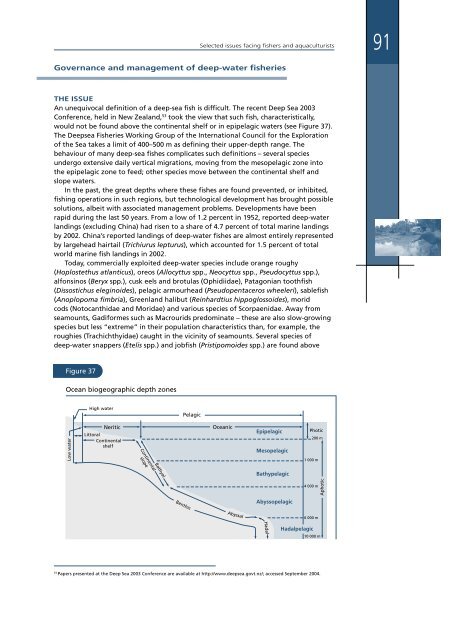State of World Fisheries and Aquaculture 2004 - Library
State of World Fisheries and Aquaculture 2004 - Library
State of World Fisheries and Aquaculture 2004 - Library
You also want an ePaper? Increase the reach of your titles
YUMPU automatically turns print PDFs into web optimized ePapers that Google loves.
Selected issues facing fishers <strong>and</strong> aquaculturists<br />
91<br />
Governance <strong>and</strong> management <strong>of</strong> deep-water fisheries<br />
THE ISSUE<br />
An unequivocal definition <strong>of</strong> a deep-sea fish is difficult. The recent Deep Sea 2003<br />
Conference, held in New Zeal<strong>and</strong>, 53 took the view that such fish, characteristically,<br />
would not be found above the continental shelf or in epipelagic waters (see Figure 37).<br />
The Deepsea <strong>Fisheries</strong> Working Group <strong>of</strong> the International Council for the Exploration<br />
<strong>of</strong> the Sea takes a limit <strong>of</strong> 400–500 m as defining their upper-depth range. The<br />
behaviour <strong>of</strong> many deep-sea fishes complicates such definitions – several species<br />
undergo extensive daily vertical migrations, moving from the mesopelagic zone into<br />
the epipelagic zone to feed; other species move between the continental shelf <strong>and</strong><br />
slope waters.<br />
In the past, the great depths where these fishes are found prevented, or inhibited,<br />
fishing operations in such regions, but technological development has brought possible<br />
solutions, albeit with associated management problems. Developments have been<br />
rapid during the last 50 years. From a low <strong>of</strong> 1.2 percent in 1952, reported deep-water<br />
l<strong>and</strong>ings (excluding China) had risen to a share <strong>of</strong> 4.7 percent <strong>of</strong> total marine l<strong>and</strong>ings<br />
by 2002. China’s reported l<strong>and</strong>ings <strong>of</strong> deep-water fishes are almost entirely represented<br />
by largehead hairtail (Trichiurus lepturus), which accounted for 1.5 percent <strong>of</strong> total<br />
world marine fish l<strong>and</strong>ings in 2002.<br />
Today, commercially exploited deep-water species include orange roughy<br />
(Hoplostethus atlanticus), oreos (Allocyttus spp., Neocyttus spp., Pseudocyttus spp.),<br />
alfonsinos (Beryx spp.), cusk eels <strong>and</strong> brotulas (Ophidiidae), Patagonian toothfish<br />
(Dissostichus eleginoides), pelagic armourhead (Pseudopentaceros wheeleri), sablefish<br />
(Anoplopoma fimbria), Greenl<strong>and</strong> halibut (Reinhardtius hippoglossoides), morid<br />
cods (Notocanthidae <strong>and</strong> Moridae) <strong>and</strong> various species <strong>of</strong> Scorpaenidae. Away from<br />
seamounts, Gadiformes such as Macrourids predominate – these are also slow-growing<br />
species but less “extreme” in their population characteristics than, for example, the<br />
roughies (Trachichthyidae) caught in the vicinity <strong>of</strong> seamounts. Several species <strong>of</strong><br />
deep-water snappers (Etelis spp.) <strong>and</strong> jobfish (Pristipomoides spp.) are found above<br />
<br />
<br />
<br />
<br />
<br />
<br />
<br />
<br />
<br />
<br />
<br />
<br />
<br />
<br />
<br />
<br />
<br />
<br />
<br />
<br />
<br />
<br />
<br />
<br />
<br />
<br />
<br />
<br />
53<br />
Papers presented at the Deep Sea 2003 Conference are available at http://www.deepsea.govt.nz/; accessed September <strong>2004</strong>.

















